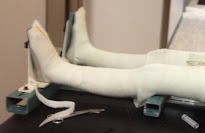Today I'd like to share information about the process of getting KAFOs (Knee-Ankle-Foot Orthoses). As usual, nothing here reflects a medical recommendation, professional opinion, or endorsement. Note also that I receive no money or compensation for any of the products named. I write about my own experiences and hope that they encourage others to keep moving forward. Please seek advice from medical professionals and physical therapists.
With that disclaimer, if you want to know more about KAFOs, where to start? If you're like me and you have a spinal cord injury or similar neurological condition, or if you know someone who does, you may already have passed time surfing the internet. I spent hours doing general research about leg braces. There are a lot different types of bracing to help with therapy and functional walking. HKAFOs (Hip-Knee-Ankle-Foot Orthoses) extend up around the hips and include a belt or back bracing, KAFOs generally run from mid-thigh down, and AFOs (Ankle-Foot Orthoses) are used for bracing below the knees. (To learn more about types of leg braces and to see pictures, click here.) Within these categories, realize that braces provide varying levels of support. They may be sturdier for users with very little muscle function, or be relatively lightweight, intended to offer supplemental support for toe droop or knee buckling. Newer models of some of these braces are mechanically assistive with springs, or feature robotic stance control that responds to muscle movement.
Over time, I've tried HKAFOs, KAFOs, and AFOs of multiple types (thank you, Hanger!), including stance control C-braces, polypropylene plastic and carbon fiber AFOs, thermoplastic heavy-duty KAFOs, modular KAFOs (my name for the Allards Combo brand), and (H)KAFOs with a hip belt and the Up and Go bracket system for gait stabilization. I consider myself blessed to have had the opportunity to experiment with various kinds of bracing. Sometimes braces have to be fitted directly for the user and cannot be used on a trial basis, or are too expensive and rare for clinics to have on-hand.
To schedule an appointment with an orthotist, I had to have a doctor's written approval (a scrip). Insurance wants the document to show that braces are medically necessary or beneficial for your health. I talked with my insurance provider directly and asking about leg braces as authorized Durable Medical Equipment. I would suppose that spine centers or specialty clinics devoted to SCI rehab have standard ways of doing all of this.
The first visit at the orthotics clinic was an assessment of the injury and its specific impact. This stage was mostly answering questions. What muscles were functioning? What was my level of independence at different tasks, such as sitting up or leaning over? Did I have any walking ability? I was using a wheelchair for mobility at the time and had a little hip function. When my knees were blocked or locked straight, I could take small steps. Information like this helps determine what bracing is viable.
For me, the results were almost a disappointment. My request for braces was nearly turned down because my walking ability was very poor. Fortunately, I had a great advocate in my orthotist. If it hadn't been for him, the braces would never have happened. (If you know much about SCIs, you know that opportunities can easily be shut down. Don't be discouraged and don't give up. Be persistent and pursue all your options.)
Fitting for leg braces was a separate appointment. All I had to do was
show up. The casting process was fairly straightforward. It just
involved having measurements taken and being still while the clinician
created a mold of my legs.
The molds were used to fabricate custom braces for use at home. I picked up the braces about a month later, approximately two weeks after the one-year anniversary of my accident. Since we had been able to keep my body used to being upright, I did not have to go through any stages of readjusting, such as worrying about blood pressure problems or potential blood clots. Getting used to the braces mainly meant wearing them for longer periods of time each day: an hour one day, two hours the next day, four hours the next, and so on. By July 4, I could walk down the local trail just enough to view fireworks while standing. It was a long and triumphant way from the hospital bed where I had been exactly a year earlier. Well worth it!
Obviously that isn't the whole story about long leg braces. There is much more to say about adjusting to them and using them for daily function, but I hope that these short insights will help others who are looking into leg braces. Please contact me or leave a comment below if you have any questions!






